#pro version api tool
Explore tagged Tumblr posts
Text

API (Application Programming Interface) testing is a type of software testing that aims to determine whether the applications are error-free or not.
#api testing tools#api testing tools online#api testing tools open source#api testing tools free#api testing tools paid#pro version api tool#what is api
1 note
·
View note
Text
Lazy Loading Page Speed Optimization: Efficient Practices & Tips

Key Takeaways
Lazy loading can significantly improve page speed by loading only necessary content initially, reducing initial load times.
Implementing lazy loading can save bandwidth, which is crucial for users on limited data plans.
This technique enhances user experience by ensuring faster interactions and smoother scrolling.
SEO can benefit from lazy loading as search engines prefer faster websites, potentially improving rankings.
To effectively implement lazy loading, use browser-native features and ensure compatibility across different devices.
Enhancing Web Performance with Lazy Loading
In today's fast-paced digital world, web performance is more critical than ever. Slow websites can drive users away, impacting engagement and conversions. One powerful technique to boost performance is lazy loading. By understanding and implementing lazy loading, you can optimize your website's speed and efficiency, keeping your visitors engaged and satisfied.
Understanding the Need for Speed
Users expect websites to load quickly and efficiently.
Slow loading times can lead to higher bounce rates.
Improved speed enhances user satisfaction and retention.
Most importantly, speed is not just a luxury; it's a necessity. Users are increasingly impatient, and a delay of even a few seconds can cause them to abandon your site. Therefore, ensuring that your site loads swiftly is crucial for maintaining user interest and engagement.
Lazy loading offers a solution by optimizing the loading process. Instead of loading every element of a page at once, lazy loading prioritizes essential content and defers non-essential elements. This approach can make a dramatic difference in how quickly your site feels to users.
Lazy Loading: A Game Changer for Web Efficiency
Lazy loading is more than just a buzzword; it's a transformative technique for web optimization. By deferring the loading of non-essential elements, such as images and videos, until they are needed, lazy loading reduces the initial load time of a webpage.
Images and videos load only when they enter the viewport.
Reduces server requests, enhancing page speed.
Particularly beneficial for mobile users with limited bandwidth.
Besides that, lazy loading helps in conserving resources, which is particularly beneficial for mobile users who might be on limited data plans. By only loading what's necessary, users experience faster interactions and smoother scrolling, which can significantly improve their overall experience.
Eager Loading: When Immediate Isn't Ideal
Eager loading, the opposite of lazy loading, involves loading all page elements at once. While this approach might seem straightforward, it can lead to longer initial load times, especially on content-heavy pages. Therefore, eager loading is not always the best choice, particularly when dealing with large images or videos.
Lazy loading, on the other hand, ensures that your website delivers essential content swiftly, making it an ideal choice for optimizing page speed and improving user experience.
Benefits of Lazy Loading
Lazy loading isn't just about speed; it's about creating a seamless and efficient user experience. Let's delve into the various benefits it offers.
Faster Initial Load Times
By loading only the necessary elements initially, lazy loading significantly reduces the time it takes for a page to become interactive. Users can start engaging with the content almost immediately, without waiting for all elements to load.
This immediate engagement is crucial in retaining user interest. For instance, if your homepage loads quickly, users are more likely to explore further, increasing the chances of conversion.
Additionally, faster load times can have a positive impact on your website's bounce rate. Users are less likely to leave if they don't have to wait for content to load, which can improve your site's overall performance metrics.
Loading Images Efficiently
Images often account for the majority of a webpage's load time. By implementing lazy loading for images, you can significantly improve your page speed. This involves loading images only when they are about to enter the viewport. As a result, users won't have to wait for all images to load before they can interact with your content.
To do this effectively, you can use the loading="lazy" attribute in your image tags. This attribute tells the browser to defer loading the image until it is close to being visible. Additionally, consider using responsive image techniques to serve different image sizes based on the user's device, further optimizing load times.
Handling Videos and Media Content
Videos and other media content can be resource-intensive, causing significant delays in load times if not managed properly. Lazy loading can also be applied to these elements. By embedding videos with lazy loading techniques, you ensure they only load when a user scrolls to them.
For example, instead of directly embedding a video, use a thumbnail image with a play button overlay. When the user clicks the play button, the video loads and plays. This not only saves bandwidth but also improves the initial loading speed of the page.
JavaScript and CSS Deferred Loading
JavaScript and CSS files are essential for modern web applications, but they can also be a bottleneck if not handled correctly. Lazy loading these resources involves deferring their loading until they are needed. This can be achieved using the defer and async attributes for JavaScript files.
The defer attribute ensures that the script is executed after the HTML document has been parsed, while the async attribute allows the script to be executed as soon as it's available. For CSS, consider using media queries to load stylesheets conditionally based on the user's device or viewport size.
Tips for Optimizing Lazy Loading
Implementing lazy loading is just the beginning. To truly optimize your website's performance, follow these additional tips and best practices.
Use Browser Native Features
Modern browsers offer native support for lazy loading, making it easier than ever to implement this technique. By using native features, you can ensure compatibility and reduce the need for third-party libraries, which can add unnecessary overhead.
To take advantage of these features, simply add the loading="lazy" attribute to your image and iframe tags. This simple addition can have a significant impact on your page speed, especially for image-heavy sites.
Besides, using native features ensures that your site remains future-proof, as browsers continue to enhance their support for lazy loading and other performance optimizations.
Minimize Default Image Size
Before applying lazy loading, it's crucial to optimize your images for size. Large images can still slow down load times, even with lazy loading. Use image compression tools to reduce file sizes without sacrificing quality.
Optimize Animations
Animations can enhance user experience, but they can also impact performance if not optimized. Use CSS animations instead of JavaScript whenever possible, as they are more efficient and can be hardware-accelerated by the browser.
Ensure that animations are smooth and don't cause layout shifts, which can negatively affect user experience. Test your animations on different devices to ensure they perform well across the board.
Remember, the goal is to create a seamless experience for your users. By optimizing animations, you can enhance the visual appeal of your site without compromising performance.
Test Across Multiple Devices
It's essential to test your website on a variety of devices and screen sizes. What works well on a desktop might not perform the same on a mobile device. Use tools like Google PageSpeed Insights to analyze your site's performance and identify areas for improvement.
Regular testing ensures that your lazy loading implementation works as intended across different platforms, providing a consistent experience for all users.
Overcoming Common Lazy Loading Challenges
While lazy loading offers numerous benefits, it's not without its challenges. Addressing these issues ensures that your implementation is successful and doesn't negatively impact your site.
Dealing with SEO Concerns
Lazy loading can sometimes interfere with search engine indexing if not implemented correctly. To ensure your content is indexed, use server-side rendering or provide fallbacks for search engines that may not execute JavaScript. For more insights, check out how lazy loading decreases load time and increases engagement.
Ensure all critical content is available without JavaScript.
Use structured data to help search engines understand your content.
Regularly monitor your site's indexing status in Google Search Console.
These strategies help maintain your site's visibility in search engine results, ensuring that lazy loading doesn't negatively impact your SEO efforts.
Addressing Browser Compatibility Issues
While most modern browsers support lazy loading, some older versions may not. To ensure compatibility, consider using a polyfill or fallback solutions for browsers that don't support lazy loading natively.
By addressing these compatibility issues, you can provide a consistent experience for all users, regardless of their browser choice. Regularly updating your site and testing on different browsers can help you identify and resolve any issues that arise.
Troubleshooting Loading Delays
Even with lazy loading implemented, you might encounter loading delays. This often happens when elements are not optimized or when there are too many third-party scripts running on your site. To troubleshoot these issues, start by identifying the elements that are causing delays. Use tools like Google Chrome's Developer Tools to pinpoint these elements and analyze their loading times.
Once you've identified the culprits, consider compressing images, deferring non-essential scripts, and minimizing the use of third-party plugins. By doing so, you can significantly reduce loading times and improve the overall performance of your website.
The Future of Lazy Loading in Web Development
Lazy loading is set to become an integral part of web development as websites continue to grow in complexity and size. With the increasing demand for faster and more efficient websites, lazy loading offers a practical solution to enhance user experience without compromising on content richness.
"Lazy loading is not just a trend; it's a necessity for modern web development. As websites evolve, so do the techniques we use to optimize them."
As more developers recognize the benefits of lazy loading, we can expect to see advancements in browser support and new tools that make implementation even easier. This evolution will ensure that lazy loading remains a vital component of web optimization strategies.
Emerging Technologies that Support Lazy Loading
Several emerging technologies are poised to enhance lazy loading capabilities. For instance, progressive web apps (PWAs) and server-side rendering (SSR) can work alongside lazy loading to deliver content more efficiently. PWAs offer offline capabilities and faster load times, while SSR ensures that content is rendered on the server, reducing the load on the client's device.
Additionally, advances in artificial intelligence and machine learning could further optimize lazy loading by predicting user behavior and preloading content accordingly. These technologies have the potential to revolutionize how we approach web performance optimization.
The Growing Importance of Mobile Optimization
As mobile usage continues to rise, optimizing websites for mobile devices has become more critical than ever. Lazy loading plays a crucial role in this optimization by reducing data usage and improving load times on mobile networks.
By implementing lazy loading, you can ensure that your mobile users have a seamless experience, regardless of their network conditions. This is particularly important for users in regions with slower internet speeds, where every byte counts.
Frequently Asked Questions
Lazy loading is a powerful tool, but it can also raise questions for those unfamiliar with its implementation. Here are some common questions and answers to help you better understand lazy loading and its impact on your website.
These insights will help you make informed decisions about implementing lazy loading on your site and address any concerns you may have.
"Lazy loading can seem daunting at first, but with the right guidance, it becomes an invaluable asset for web optimization."
What is lazy loading and how does it work?
Lazy loading is a technique that defers the loading of non-essential elements, such as images and videos, until they are needed. This reduces the initial load time of a webpage, allowing users to interact with the content more quickly. By only loading elements when they enter the viewport, lazy loading conserves resources and improves performance.
How does lazy loading affect page speed and SEO?
Lazy loading can significantly enhance page speed by reducing the number of elements that need to be loaded initially. This not only improves user experience but also positively impacts SEO. Search engines favor faster websites, which can lead to improved rankings.
However, it's essential to ensure that lazy loading is implemented correctly to avoid any negative impact on SEO. This includes providing fallbacks for search engines that may not execute JavaScript and ensuring that all critical content is accessible without JavaScript. For more insights, check out this beginner's guide to lazy loading.
By addressing these considerations, you can harness the benefits of lazy loading without compromising your site's visibility in search engine results.
"Faster websites are favored by both users and search engines, making lazy loading a win-win for performance and SEO."
Therefore, lazy loading is an effective strategy for enhancing both user experience and search engine rankings.
What types of content should be lazy loaded?
Lazy loading is particularly beneficial for large images, videos, and other media content that can slow down a webpage. By deferring these elements, you can ensure that users only load what they need, when they need it.
Additionally, lazy loading can be applied to JavaScript and CSS files, further optimizing load times. By prioritizing essential content and deferring non-essential elements, you can create a more efficient and user-friendly website.
Are there any drawbacks to implementing lazy loading?
While lazy loading offers numerous benefits, it does have some potential drawbacks. If not implemented correctly, it can interfere with search engine indexing and result in missing or delayed content. To mitigate these risks, ensure that your lazy loading implementation is compatible with search engines and provides fallbacks for non-JavaScript environments. For more insights, check out Boost Your Website Speed With Lazy Loading.
How do I verify if lazy loading is working on my site?
To verify that lazy loading is working, use browser developer tools to inspect the network activity. Check if images and other media elements are loading only when they enter the viewport. Additionally, tools like Google PageSpeed Insights can help you analyze your site's performance and confirm that lazy loading is functioning as intended.
By regularly monitoring your site's performance and addressing any issues that arise, you can ensure that lazy loading continues to enhance your website's speed and user experience.
#A/B testing strategies#abstract design#Adobe Sensei automation#affordable AI tools#AI capability experimentation#AI-driven design suggestions#AI-driven innovation#alternate reality game#API integration#Appointment booking#appointment cancellation policy#ARG#authentic partnership#automated resizing#background removal#behind-the-scenes content#Blue color scheme#budget-friendly design software#Canva free version#Canva Pro features#Client data protection#client feedback tools#Client testimonials#Cloud Libraries#community building#community engagement#community engagement platforms#content automation#Conversion tracking#cost-effective strategies
0 notes
Text
I know a lot of people on qsmpblr use Tumblr mobile, but if you do use browser Tumblr then I would recommend the Simple Translate extension. Because Tumblr doesn't have built in translation like Twitter, there's less fans posting in their native language, instead most people just use English.
Simple Translate is an extension that allows you to translate text that you highlight into a target language. (It uses Google Translate API, but so does Twitter so the translation quality is pretty much the same).
Firefox Extension | Chrome Extension

When you highlight text in another language, a translate icon appears, when you click on it a panel containing the translation of the text appears.

You can also change the settings of the extension so that the translation panel automatically appears when you highlight text in another language.

Here's some more examples using the official QSMP Twitter accounts, you do not need to change the settings of the extension to translate from different languages into your target language.
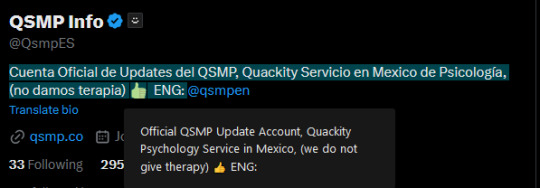



(All of these match the translations given when using the "translate bio" button on Twitter directly.)
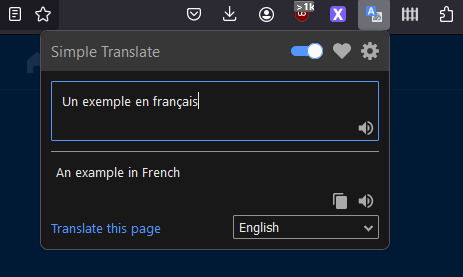
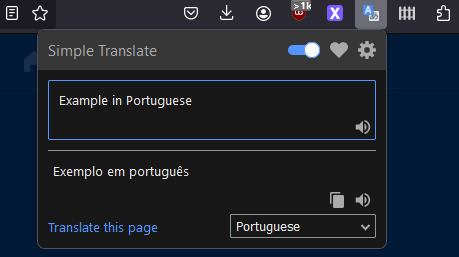
You can also access a translation box using the icon in the toolbar, any text you enter can be translated to the language selected in the drop-down menu (meaning you don't need to open a new tab to use Google Translate).
Some settings explanation and other stuff under the cut. Not super important but I figured I'd add it anyways.

There is an option to use DeepL API as opposed to Google Translate (it's another translation tool, there is free access to the API with a limit of 500,000 characters/month, and a pro version for unlimited access).
Whatever the target language is set as is what text you highlight will be translated into. There is another option for a second target language, I'll explain that further down.
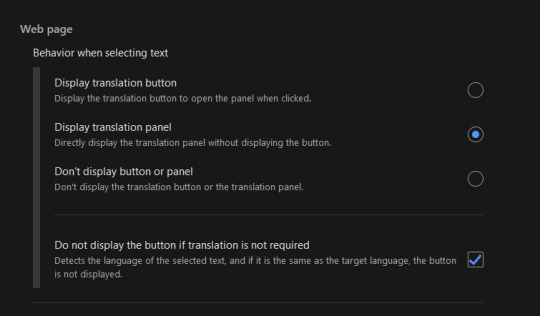
This option changes how you view the translation panel, the first option (default) has the icon appear when you highlight text (as seen in the first image of the post), the second option has the translation panel appear automatically when you highlight text, and the for third option the panel and icon won't automatically appear, but can still be accessed by right-clicking the highlighted text and selecting "translate selected text".
The checkbox below these options means that if the text you're highlighting is already in your target language, the translation icon and panel will not appear, it can again still be accessed by right-clicking what you've highlighted and selecting translate.

This option appears twice, in both the Web-page section (for translating selected text) and the Toolbar Popup section (for the translation box in the toolbar popup).
The web page option, when toggled on, means that when you select text that is in your target language, the translation panel will translate into the second target language that has been selected. If the checkbox for "do not display if translation is not required" is toggled on, you can only view the translation from Target -> 2nd Target by right-clicking to translate selected text.
The toolbar popup version of this option is used to automatically switch the language in the toolbar translation box when you input something in your main target. (ie. second target set to French means that when you input English text in the translation box it will switch the translation setting from "(detect language) -> English" to "English -> French").
There are also settings to change the style and size of the translation button and panel.
Side note: Mixed language messages (not containing your target language) will only translate one of the languages, you can work around this by highlighting the different languages separately.
Links again if you don't want to scroll all the way back up
Firefox Extension | Chrome Extension
#if you use twitter and want to crosspost this feel free#but please link to this post and perhaps paste the post text into the alt text of the screenshot#so people can translate the post text from english to their own language (or honestly feel free to translate it yourself and post that too)#qsmp#qsmpblr#qsmptwt#i think this could also maybe be useful for tweets that arent detected as another language so the translate option doesnt appear?#idk i dont use twt much#idk if anything like this has been posted before tbh#i just enjoy seeing people speaking in their native languages over on qsmptwt and when it occasionally happens here too#and i think itd be pretty cool to see it more on qsmpblr#tiggady tags#also i figure it could be useful translating from english into ur native lang!!! forgot to mention that in the post
788 notes
·
View notes
Text
PSA: Free Software
Reading this may really save your time, privacy, and money! Reblog or share to spread awareness!
Folks often use software that’s expensive and sometimes even inferior because they don’t know there are alternatives. So to those unfamiliar: basically, free and open-source (FOSS) or "libre" software is free to use and anyone can access the original code to make their own version or work on fixing problems.
That does not mean anyone can randomly add a virus and give it to everyone—any respectable libre project has checks in place to make sure changes to the official version are good! Libre software is typically developed by communities who really care about the quality of the software as a goal in itself.
There are libre alternatives to many well-known programs that do everything an average user needs (find out more under the cut!) for free with no DRM, license keys, or subscriptions.
Using libre software when possible is an easy way to fight against and free yourself from corporate greed while actually being more convenient in many cases! If you need an app to do something, perhaps try searching online for things like:
foss [whatever it is]
libre [whatever it is]
open source [whatever it is]
Feel free to recommend more libre software in the tags, replies, comments, or whatever you freaks like to do!
Some Libre Software I Personally Enjoy…
LibreOffice
LibreOffice is an office suite, much like Microsoft Office. It includes equivalents for apps like Word, Excel, and Powerpoint, which can view and edit files created for those apps.

I can't say I've used it much myself yet. I do not personally like using office software except when I have to for school.
OpenShot
OpenShot Video Editor is, as the name suggests, a video editing program. It has industry-standard features like splicing, layering, transitions, and greenscreen.
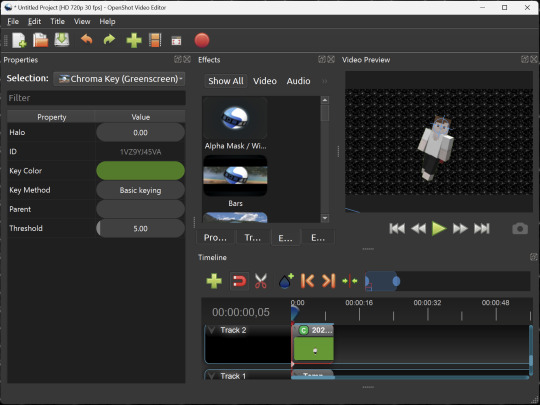
I've only made one video with it so far, but I'm already very happy with it. I had already paid for a video editor (Cyberlink PowerDirector Pro), but I needed to reinstall it and I didn't remember how. Out of desperation, I searched up "FOSS video editor" and I'm so glad I did. There's no launcher, there's no promotion of other apps and asset packs—it's just a video editor with a normal installer.
GIMP
GNU Image Manipulation Program is an image editor, much like Photoshop. Originally created for Linux but also available for Windows and MacOS, it provides plenty of functionality for editing images. It is a bit unintuitive to learn at first, though.

I've used it to create and modify images for years, including logos, really bad traceover art, and Minecraft textures. It doesn't have certain advanced tech like AI paint-in, but it has served my purposes well and it might just work for yours!
(Be sure to go to Windows > Dockable Dialogs > Colors. I have no idea why that's not enabled by default.)
Audacity
Audacity is an audio editing program. It can record, load, splice, and layer audio files and apply effects to them.

Audacity is another program I've used for a long time. It is not designed to compose music, but it is great for podcasts, simple edits, and loading legacy MS Paint to hear cool noises.
7-Zip
7-Zip is a file manager and archive tool. It supports many archive types including ZIP, RAR, TAR, and its own format, 7Z. It can view and modify the contents of archives, encrypt and decrypt archives, and all that good stuff.

Personally, I use 7-Zip to look inside JAR files for Minecraft reasons. I must admit that its UI is ugly.
Firefox
Firefox is an internet browser, much like Google Chrome, Microsoft Edge, or Safari. While browsers are free, many of them include tracking or other anti-consumer practices. For example, Google plans to release an update to Chromium (the base that most browsers are built from these days) that makes ad blockers less effective by removing the APIs they currently rely on.
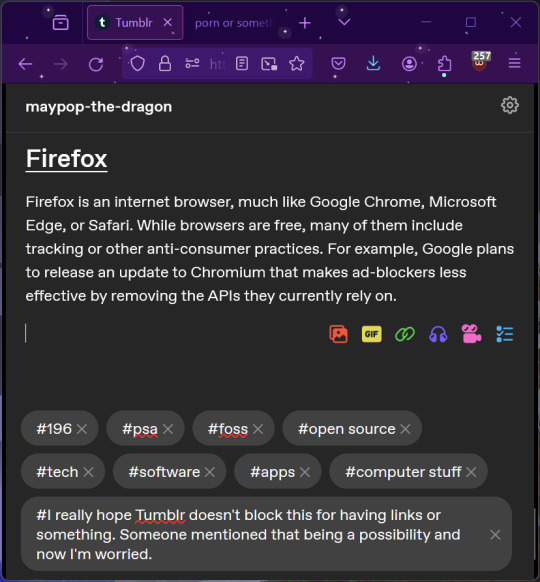
Aside from fighting monopolies, benefits include: support for animated themes (the one in the picture is Purple Night Theme), good ad blockers forever, an (albeit hidden) compact UI option (available on about:config), and a cute fox icon.
uBlock Origin
As far as I know, uBlock Origin is one of the best ad blockers there is.
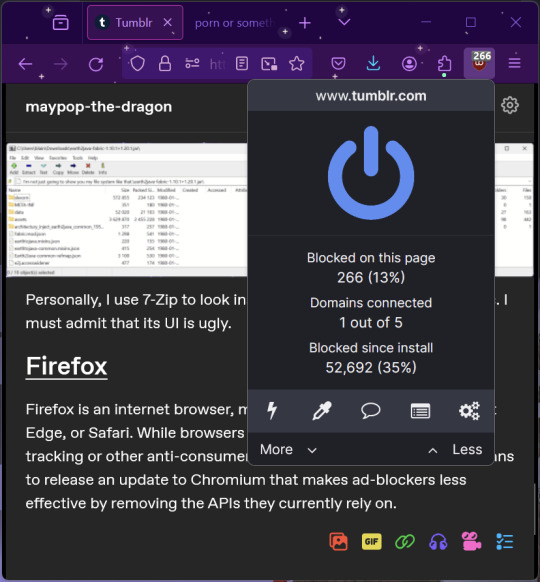
I was on a sketchy website with my brother, and he was using Opera GX's ad blocker. Much of the time when he clicked on anything, it would take us to a random sponsored page. I suggested that he try uBlock Origin, and with uBlock Origin, that didn't happen anymore.
Linux
Linux is a kernel, but the term is often used to refer to operating systems (much like Windows or MacOS) built on it. There are many different Linux-based operating systems (or "distros") to choose from, but apps made for Linux usually work on most popular distros. You can also use many normally Windows-only apps on Linux through compatibility layers like WINE.



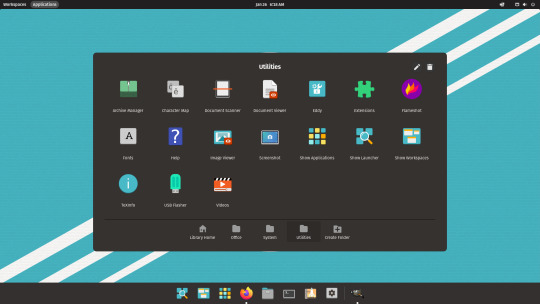
I don't have all four of these, so the images are from Wikipedia. I tried to show a variety of Linux distros made for different kinds of users.
If you want to replace your operating system, I recommend being very careful because you can end up breaking things. Many computer manufacturers don't care about supporting Linux, meaning that things may not work (Nvidia graphic cards notoriously have issues on Linux, for example).
Personally, I tried installing Pop!_OS on a laptop, and the sound output mysteriously doesn't work. I may try switching to Arch Linux, since it is extremely customizable and I might be able to experiment until I find a configuration where the audio works.
Many Linux distros offer "Live USB" functionality, which works as both a demo and an installer. You should thoroughly test your distro on a Live USB session before you actually install it to be absolutely sure that everything works. Even if it seems fine, you should probably look into dual-booting with your existing operating system, just in case you need it for some reason.
Happy computering!
#196#psa#foss#open source#tech#software#apps#computer stuff#I really hope Tumblr doesn't block this for having links or something. Someone mentioned that being a possibility and now I'm worried.#please reblog#2024-01-26
47 notes
·
View notes
Text
Unlock creative insights with AI instantly
What if the next big business idea wasn’t something you “thought of”… but something you unlocked with the right prompt? Introducing Deep Prompt Generator Pro — the tool designed to help creators, solopreneurs, and future founders discover high-impact business ideas with the help of AI.
💡 The business idea behind this very video? Generated using the app. If you’re serious about building something real with ChatGPT or Claude, this is the tool you need to stop wasting time and start creating real results.
📥 Download the App: ✅ Lite Version (Free) → https://bit.ly/DeepPromptGeneratorLite 🔓 Pro Version (Full Access) → https://www.paypal.com/ncp/payment/DH9Z9LENSPPDS
🧠 What Is It? Deep Prompt Generator Pro is a lightweight desktop app built to generate structured, strategic prompts that help you:
✅ Discover profitable niches ✅ Brainstorm startup & side hustle ideas ✅ Find monetization models for content or products ✅ Develop brand hooks, angles, and offers ✅ Unlock creative insights with AI instantly
Whether you’re building a business, launching a new product, or looking for your first real side hustle — this app gives your AI the clarity to deliver brilliant results.
🔐 Features: Works completely offline No API or browser extensions needed Clean UI with categorized prompts One-click copy to paste into ChatGPT or Claude System-locked premium access for security
🧰 Who It’s For: Founders & solopreneurs Content creators Side hustlers AI power users Business coaches & marketers Anyone who’s tired of “mid” AI output
📘 PDF Guide Included – Every download includes a user-friendly PDF guide to walk you through features, categories, and how to get the best results from your prompts.
📂 Pro Version includes exclusive prompt packs + priority access to new releases.
🔥 Watch This If You’re Searching For: how to use ChatGPT for business ideas best prompts for startup founders AI tools for entrepreneurs side hustle generators GPT business prompt generator AI idea generator desktop app ChatGPT for content creators
📣 Final Call to Action: If this tool gave me a business idea worth filming a whole video about, imagine what it could help you discover. Stop guessing — start prompting smarter.
🔔 Subscribe to The App Vault for weekly tools, apps, and automation hacks that deliver real results — fast.🔓 Unlock Your PC's Full Potential with The App Vault Tiny Tools, Massive Results for Productivity Warriors, Creators & Power Users
Welcome to The App Vault – your ultimate source for lightweight desktop applications that deliver enterprise-grade results without bloatware or subscriptions. We specialize in uncovering hidden gem software that transforms how creators, freelancers, students, and tech enthusiasts work. Discover nano-sized utilities with macro impact that optimize workflows, turbocharge productivity, and unlock creative potential.
🚀 Why Our Community Grows Daily: ✅ Zero Fluff, Pure Value: 100% practical tutorials with actionable takeaways ✅ Exclusive Tools: Get first access to our custom-built apps like Deep Prompt Generator Pro ✅ Underground Gems: Software you won't find on mainstream tech channels ✅ Performance-First: Every tool tested for system efficiency and stability ✅ Free Resources: Download links + config files in every description
🧰 CORE CONTENT LIBRARY: ⚙️ PC Optimization Arsenal Windows optimization secrets for buttery-smooth performance System cleanup utilities that actually remove 100% of junk files Memory/RAM optimizers for resource-heavy workflows Startup managers to slash boot times by up to 70% Driver update automation tools no more manual hunting Real-time performance monitoring dashboards
🤖 AI Power Tools Local AI utilities that work offline for sensitive data Prompt engineering masterclass series Custom AI workflow automations Desktop ChatGPT implementations Niche AI tools for creators: image upscalers, script generators, audio enhancers AI-powered file organization systems
⏱️ Productivity Boosters Single-click task automators Focus enhancers with distraction-killing modes Micro-utilities for batch file processing Smart clipboard managers with OCR capabilities Automated backup solutions with versioning Time-tracking dashboards with productivity analytics
🎨 Creative Workflow Unlockers Content creation accelerators for YouTubers Automated thumbnail generators Lightweight video/audio editors 50MB Resource-efficient design tools Cross-platform project synchronizers Metadata batch editors for digital assets
🔍 Niche Tool Categories Open-source alternatives to expensive software Security tools for privacy-conscious users Hardware diagnostic toolkits Custom scripting utilities for power users Legacy system revival tools
youtube
#DeepPromptGenerator#BusinessIdeas#ChatGPTPrompts#SideHustleIdeas#StartupIdeas#TheAppVault#PromptEngineering#AIProductivity#SolopreneurTools#TinyToolsBigImpact#DesktopApp#ChatGPTTools#FiverrApps#Youtube
2 notes
·
View notes
Text
Distribute.so is a platform designed to streamline the process of distributing content, particularly digital media, across multiple platforms and channels. It caters to creators, marketers, and businesses aiming to maximize their reach and efficiency in content distribution. Below is a detailed review of its features and functionalities:
Key Features Multi-Platform Distribution:
Wide Reach: Distribute.so allows users to publish content across various platforms such as social media channels, blogs, video sites, and more, all from a single interface. Automated Posting: The platform supports automated scheduling and posting, ensuring consistent presence without manual intervention. Content Management:
Centralized Dashboard: Users can manage all their content distribution activities from a centralized dashboard, providing an overview of scheduled, pending, and completed posts. Content Calendar: An integrated content calendar helps in planning and organizing content distribution schedules, making it easier to manage campaigns. Analytics and Reporting:
Performance Metrics: Distribute.so provides detailed analytics on content performance across different platforms, including engagement metrics, reach, and conversion rates. Custom Reports: Users can generate custom reports to analyze the effectiveness of their distribution strategies and make data-driven decisions. Integration Capabilities:
Third-Party Integrations: The platform integrates with various third-party tools such as social media management tools, CRM systems, and analytics platforms, enhancing its functionality and ease of use. API Access: For advanced users, API access allows for custom integrations and automation tailored to specific needs. User Collaboration:
Team Collaboration: Distribute.so supports multiple user roles and permissions, enabling teams to collaborate on content distribution tasks efficiently. Approval Workflows: Built-in approval workflows ensure that content is reviewed and approved before it goes live, maintaining quality control. Content Optimization:
SEO Tools: The platform offers tools to optimize content for search engines, improving visibility and reach. A/B Testing: Users can perform A/B testing on different content versions to determine which performs better, refining their distribution strategies. Customization and Branding:
Custom Templates: Users can create and use custom templates for different types of content, ensuring consistency in branding and presentation. Branded Content: The platform allows for branded content distribution, helping businesses maintain their brand identity across various channels.
Pros Efficiency in Distribution: Distribute.so significantly reduces the time and effort required to distribute content across multiple platforms, improving efficiency. Comprehensive Analytics: Detailed performance metrics and custom reports provide valuable insights into the effectiveness of content distribution strategies. Integration and API: Robust integration capabilities and API access enhance the platform’s flexibility and usability. User-Friendly Interface: The centralized dashboard and intuitive interface make it easy for users to manage their content distribution tasks. Team Collaboration: Support for team collaboration and approval workflows ensures streamlined and controlled content distribution.
Cons Cost: Depending on the pricing structure, Distribute.so might be relatively expensive for small businesses or individual creators with limited budgets. Learning Curve: New users may require some time to fully understand and utilize all the features, especially advanced functionalities. Platform-Specific Limitations: While Distribute.so supports a wide range of platforms, there may be limitations or nuances specific to certain platforms that users need to be aware of.
Distribute.so is a robust and efficient tool for content creators, marketers, and businesses looking to maximize their reach through streamlined content distribution. Its wide range of features, including multi-platform distribution, centralized content management, detailed analytics, and robust integration capabilities, make it a valuable asset for managing digital media presence. While the cost and potential learning curve are considerations, the overall benefits in terms of efficiency, performance insights, and team collaboration provide significant value. Distribute.so is particularly well-suited for users seeking to enhance their content distribution strategies and achieve greater impact across multiple channels.
5 notes
·
View notes
Text
Writeup: AOpen i945GMm-HL shenanigans
AOpen i945GMm-HL - The Retro Web
Welp. This board is weirder than I ever thought it'd be. Not the board in general, but the specific one I bought.
To begin, it turns out that my particular board, and likely many others of the same model, are OEM-customized boards that AOpen provided to a little company called RM Education. They make all-in-one PCs for the UK market.
...And they are using evaluation BIOSes (in other words, BIOS software that's normally only meant for prototyping and... well, evaluation) in their retail boards.
My specific board contains BIOS version R1.08, which is actually R1.02 apparently. There is evidence of an R1.07 existing as well from a reddit thread on the r/buildapc subreddit, but I doubt that it's been dumped anywhere.
Moving on to the original point of this writeup, I got this board because I wanted to build a system that pushed the 32-bit Core Duo T2700 as far as possible, meaning I needed a mobile-on-desktop board. AOpen built a reputation for doing this sorta stuff in the 2000s, so I went ahead and picked one of their boards for use (although I would've much preferred using the top of the line AOpen i975Xa-YDG instead if it were being sold anywhere. That's a VERY tasty looking board with its full size DIMM slots and SLI-compatible dual PCIe x16 slots and ability to crank the FSB all the way to 305MHz).
Slightly surprisingly, the Core Duo T2700 is quite the overclocker! It's able to push from 2.3GHz all the way up to 2.7GHz with some FSB overclocking using the SetFSB tool. It's multiplier-locked to a range from 6.0 to 14.0, so I can only push it through this means.
The board I'm using, the AOpen i945GMm-HL, supports running the FSB up to 195MHz. It's okay-ish in terms of stability, but crashes when running Aida64 benchmarks unless I loosen the memory timings from the 5-5-5-15 settings that it uses at 333MHz to 5-6-6-18, which is just the tiniest bit faster than its stock settings for 400MHz operation by SPD. With these settings, it's much more stable and is able to run the benchmarks, though unless I lower the FSB from 195MHz to 190, it will consistently crash Chrome when trying to play Youtube videos on integrated graphics. I'll likely experiment some to see if adding a card capable of handling the video playback in hardware helps.
For now, this is all for this blog post. I'll follow-up with more details as they come in reblogs. As follows are the specs of the system:
AOpen i945GMm-HL (OC'ed from 166MHz FSB to 195MHz, 190MHz for more stability)
Intel Core Duo T2700 @ 2.7GHz (OC'ed from 2.3GHz)
2x 2GB Crucial DDR2 SO-DIMMs @ 5-6-6-18 timings
Some random 40GB Hitachi hdd lol
Windows XP Pro SP3, fully updated via LegacyUpdate
Supermium Browser (fork of Google Chrome and the reason why I was able to test Youtube playback in the first place)
Coming up: Installing One-Core-API and Java 21 to play Minecraft 1.21 on a 32-bit system out of spite for Microsoft "dropping support" for 32-bit CPUs.
2 notes
·
View notes
Text
Navigating the Pros and Cons of Selenium for Web Application Testing
Introduction: In the dynamic world of software development, automated testing is a cornerstone of ensuring product quality and reliability. Among the myriad of tools available for automated testing, Selenium stands out as a leading choice for testing web applications. In this comprehensive exploration, we'll dissect the advantages and disadvantages of Selenium, providing insights to aid in your decision-making process when selecting a testing tool.

Advantages of Selenium:
Cross-Browser Compatibility: Selenium boasts seamless compatibility across various web browsers, including Chrome, Firefox, Safari, and Internet Explorer. This ensures consistent performance and functionality across diverse platforms, enhancing the overall user experience.
Open-Source Foundation: Selenium's open-source nature not only makes it freely accessible but also fosters a collaborative community of developers. This community-driven approach facilitates continuous improvement and innovation, ensuring that Selenium remains at the forefront of automated testing technology.
Flexibility in Language Support: Selenium supports multiple programming languages, such as Java, Python, C#, Ruby, and JavaScript. This versatility empowers testers to leverage their language of choice, enhancing productivity and enabling seamless integration with existing workflows.
Integration with Testing Frameworks: Selenium seamlessly integrates with popular testing frameworks like TestNG, JUnit, and NUnit. This integration enhances test management capabilities and facilitates streamlined reporting, enabling efficient tracking of test results and issues.
Robust WebDriver API: Selenium's WebDriver API offers a robust and intuitive interface for automating web interactions. Testers can easily create and maintain test scripts, streamlining the testing process and minimizing manual effort.
Parallel Testing Capabilities: Selenium Grid enables parallel execution of tests across multiple browsers and environments. This parallel testing capability accelerates test execution, reduces time-to-market, and enhances test coverage, ultimately improving overall testing efficiency.
Extensive Ecosystem of Tools and Plugins: Selenium boasts an extensive ecosystem of tools and plugins that extend its functionality. From Selenium IDE for record-and-playback functionality to Selenium WebDriver for programmatic test automation, testers have access to a diverse range of tools to meet their specific testing needs.

Disadvantages of Selenium:
Limited Support for Desktop and Mobile Applications: Selenium primarily focuses on web application testing and may lack robust support for testing desktop and mobile applications. Testers may need to explore additional tools and frameworks to achieve comprehensive test coverage across diverse platforms.
Steep Learning Curve: Selenium's rich feature set and versatility may present a steep learning curve, particularly for novice testers. Mastering Selenium's APIs and best practices may require significant time and effort, potentially delaying the adoption and implementation of automated testing.
Dependency on Browser Automation: Selenium's reliance on browser automation exposes test scripts to potential fragility and failures. Changes in browser versions or website structures may necessitate frequent updates and maintenance of test scripts to ensure their reliability and effectiveness.
Lack of Built-In Reporting: Selenium lacks built-in reporting capabilities, requiring testers to rely on third-party tools or custom scripts for generating comprehensive test reports. This additional overhead may increase the complexity and maintenance of test automation frameworks.
Limited Support for Non-Web Technologies: While Selenium excels in web application testing, it may offer limited support for testing non-web technologies such as APIs, databases, and mobile devices. Testers may need to supplement Selenium with additional tools and frameworks to achieve comprehensive test coverage across diverse technologies.
Resource Intensive Execution: Executing tests with Selenium, especially in parallel or on cloud-based Selenium Grids, may be resource-intensive. Testers must ensure adequate infrastructure and resources to support the scalability and performance requirements of their automated testing efforts.
Conclusion: In conclusion, Selenium emerges as a powerful tool for automated testing of web applications, offering numerous advantages such as cross-browser compatibility, open-source accessibility, and robust WebDriver API. However, it also presents certain challenges and limitations, including a steep learning curve, dependency on browser automation, and limited support for non-web technologies.
By carefully evaluating the pros and cons of Selenium and considering your specific testing requirements, you can make informed decisions about whether Selenium aligns with your automated testing needs. Ultimately, Selenium remains a top choice for testers seeking to ensure the quality and reliability of web applications in today's fast-paced development landscape.
3 notes
·
View notes
Text
Overcoming Common Challenges in Custom Video Production for Advertisers
We all understand video is marketing gold. It is engaging, emotional, and converts like crazy. But after talking to any advertiser who has tried to produce custom video at scale, they are all going to tell you the same thing: “It’s hard, like really hard.”
From budgets growing, and creative blockage, custom video production tips can come with some challenges. However, with smart tools and a little foresight, you can turn these challenges into opportunities for standout campaigns.
Challenge 1: Production Bottlenecks
Scripts, edits, approvals, and repeat. Even short videos can take weeks if your process is messy. So, what’s the solution? Make pre-production easier with templates and scriptwriting tools.
Using video production optimization that automates the process, you can create personalized video content in minutes instead of days.
Pro tip: Integrate your video workflow with your CRM and auto-fill customer details. Imagine your video saying, “Hey, [first name], check this out!” without the manual labor.
Challenge 2: Sky-High Costs
With crew, equipment, and post-production, traditional custom videos can be expensive. But the good news? You don’t always need a whole film set to get people to look.
Branded video workflows, where pre-shot elements get customized and modeled based on dynamic content, can limit costs while maximizing impact. Added benefit? You will be able to send that polished video through SMS, RCS, or WhatsApp with Sinch’s messaging APIs, cutting out expensive media buying.
Challenge 3: Consistency Across Channels
Your video shines on YouTube, but falls apart on email or chat. Not all platforms are equal. Approach? Think channel-in. Square for social, vertical for mobile, short, and sweet for RCS.
A high-end platform helps you optimize delivery based on where your customers are and what the medium needs to be, so the right version always hits the right screen.
Challenge 4: Personalization Paralysis
Custom video is personal, until it isn’t. This is where automation intersects with creativity. Automating video personalization with dynamic fields, behavioral triggers, and existing templates helps you create one-to-one feeling videos at a one-to-many scale.
Customers notice the difference, and so does your ROI!
Wrapping Up
Custom video shouldn’t be stressful! With a structured strategy and effective automation tools, you can manage every headache and transform your video efforts into scalable, profit-driving brand moments.
1 note
·
View note
Text
Software Development Process—Definition, Stages, and Methodologies

In the rapidly evolving digital era, software applications are the backbone of business operations, consumer services, and everyday convenience. Behind every high-performing app or platform lies a structured, strategic, and iterative software development process. This process isn't just about writing code—it's about delivering a solution that meets specific goals and user needs.
This blog explores the definition, key stages, and methodologies used in software development—providing you a clear understanding of how digital solutions are brought to life and why choosing the right software development company matters.
What is the software development process?
The software development process is a series of structured steps followed to design, develop, test, and deploy software applications. It encompasses everything from initial idea brainstorming to final deployment and post-launch maintenance.
It ensures that the software meets user requirements, stays within budget, and is delivered on time while maintaining high quality and performance standards.
Key Stages in the Software Development Process
While models may vary based on methodology, the core stages remain consistent:
1. Requirement Analysis
At this stage, the development team gathers and documents all requirements from stakeholders. It involves understanding:
Business goals
User needs
Functional and non-functional requirements
Technical specifications
Tools such as interviews, surveys, and use-case diagrams help in gathering detailed insights.
2. Planning
Planning is crucial for risk mitigation, cost estimation, and setting timelines. It involves
Project scope definition
Resource allocation
Scheduling deliverables
Risk analysis
A solid plan keeps the team aligned and ensures smooth execution.
3. System Design
Based on requirements and planning, system architects create a blueprint. This includes:
UI/UX design
Database schema
System architecture
APIs and third-party integrations
The design must balance aesthetics, performance, and functionality.
4. Development (Coding)
Now comes the actual building. Developers write the code using chosen technologies and frameworks. This stage may involve:
Front-end and back-end development
API creation
Integration with databases and other systems
Version control tools like Git ensure collaborative and efficient coding.
5. Testing
Testing ensures the software is bug-free and performs well under various scenarios. Types of testing include:
Unit Testing
Integration Testing
System Testing
User Acceptance Testing (UAT)
QA teams identify and document bugs for developers to fix before release.
6. Deployment
Once tested, the software is deployed to a live environment. This may include:
Production server setup
Launch strategy
Initial user onboarding
Deployment tools like Docker or Jenkins automate parts of this stage to ensure smooth releases.
7. Maintenance & Support
After release, developers provide regular updates and bug fixes. This stage includes
Performance monitoring
Addressing security vulnerabilities
Feature upgrades
Ongoing maintenance is essential for long-term user satisfaction.
Popular Software Development Methodologies
The approach you choose significantly impacts how flexible, fast, or structured your development process will be. Here are the leading methodologies used by modern software development companies:
🔹 Waterfall Model
A linear, sequential approach where each phase must be completed before the next begins. Best for:
Projects with clear, fixed requirements
Government or enterprise applications
Pros:
Easy to manage and document
Straightforward for small projects
Cons:
Not flexible for changes
Late testing could delay bug detection
🔹 Agile Methodology
Agile breaks the project into smaller iterations, or sprints, typically 2–4 weeks long. Features are developed incrementally, allowing for flexibility and client feedback.
Pros:
High adaptability to change
Faster delivery of features
Continuous feedback
Cons:
Requires high team collaboration
Difficult to predict final cost and timeline
🔹 Scrum Framework
A subset of Agile, Scrum includes roles like Scrum Master and Product Owner. Work is done in sprint cycles with daily stand-up meetings.
Best For:
Complex, evolving projects
Cross-functional teams
🔹 DevOps
Combines development and operations to automate and integrate the software delivery process. It emphasizes:
Continuous integration
Continuous delivery (CI/CD)
Infrastructure as code
Pros:
Faster time-to-market
Reduced deployment failures
🔹 Lean Development
Lean focuses on minimizing waste while maximizing productivity. Ideal for startups or teams on a tight budget.
Principles include:
Empowering the team
Delivering as fast as possible
Building integrity in
Why Partnering with a Professional Software Development Company Matters
No matter how refined your idea is, turning it into a working software product requires deep expertise. A reliable software development company can guide you through every stage with
Technical expertise: They offer full-stack developers, UI/UX designers, and QA professionals.
Industry knowledge: They understand market trends and can tailor solutions accordingly.
Agility and flexibility: They adapt to changes and deliver incremental value quickly.
Post-deployment support: From performance monitoring to feature updates, support never ends.
Partnering with professionals ensures your software is scalable, secure, and built to last.
Conclusion: Build Smarter with a Strategic Software Development Process
The software development process is a strategic blend of analysis, planning, designing, coding, testing, and deployment. Choosing the right development methodology—and more importantly, the right partner—can make the difference between success and failure.
Whether you're developing a mobile app, enterprise software, or SaaS product, working with a reputed software development company will ensure your vision is executed flawlessly and efficiently.
📞 Ready to build your next software product? Connect with an expert software development company today and turn your idea into an innovation-driven reality!
0 notes
Text
Tools to Track and Enforce Copyright Online in 2025

In the digital-first world of 2025, content is everywhere—and so is content theft. From images and blog posts to videos, music, and software code, creators face a constant threat of unauthorized use. Fortunately, technology has evolved too. Today, several advanced tools can track and enforce copyright online, empowering creators and businesses to protect their intellectual property with greater precision.
Whether you're an individual artist, a media company, or a digital agency, combining the right tools with copyright registration in Delhi offers a solid legal and technical shield against infringement.
Why Copyright Enforcement Matters More Than Ever
While copyright registration in Delhi legally protects your content, enforcement is where the real battle lies. In 2025, with AI-generated content, NFTs, and cross-platform content distribution becoming the norm, tracking misuse has become more complex.
That’s why both creators and businesses now rely heavily on technology to:
Monitor content usage globally
Detect unauthorized reproductions
Initiate takedown requests or legal action
With the help of copyright consultants in Delhi, these tools can be effectively integrated into your IP protection strategy.
Top Tools to Track and Enforce Copyright Online in 2025
1. Pixsy
Pixsy uses AI to scan the internet for your copyrighted images. It detects exact and modified copies, offering tools to send takedown notices or pursue licensing/claims.
Best for: Photographers, designers, and content creators
Integration: Works with platforms like Flickr, Dropbox, and Instagram
2. Copyscape
A long-time favorite for detecting plagiarism, Copyscape now offers real-time scanning, AI-based detection, and automated alerts for duplicate content online.
Best for: Bloggers, SEO agencies, publishers
Pro Version: Includes batch search and copy-paste content checks
3. Google Reverse Image Search (2025 Enhanced Version)
With AI advancements, Google now offers high-accuracy image recognition and flagging features to help you track where your visual content is being used.
Best for: Basic visual content checks
Free & user-friendly
4. YouTube Content ID
For video creators, YouTube Content ID allows you to automatically detect and claim unauthorized use of your videos across the platform.
Best for: Musicians, video bloggers, studios
Offers monetization or takedown options
5. DMCA.com Protection Tools
DMCA.com offers monitoring tools, automated takedown templates, and badges to discourage theft. In 2025, it also includes AI-driven alerts and takedown automation.
Best for: Website owners and eCommerce platforms
Includes API integrations for larger businesses
6. Smart Blockchain Trackers
Emerging blockchain-based copyright trackers use decentralized ledgers to timestamp content creation and track use across networks.
Best for: NFT creators, authors, software developers
Provides immutable proof of ownership
The Role of Copyright Registration in Delhi
Using these tools is powerful, but combining them with official copyright registration in Delhi gives you the legal strength needed to enforce your rights.
Here’s why:
Registered copyright serves as prima facie legal evidence in court
Enables you to claim statutory damages and take quicker action
Supports DMCA takedown notices and international protection
You can begin copyright registration online in Delhi through the Copyright Office portal, but professional help can simplify and speed up the process.
How Copyright Consultants in Delhi Can Help
Professional copyright registration consultants in Delhi do more than just file applications. They help:
Evaluate what can be copyrighted
Draft and file applications accurately
Monitor for infringement post-registration
Guide on legal action and takedown strategies
By combining tech-based enforcement tools with the expertise of copyright consultants in Delhi, creators can secure both legal rights and practical protection.
Final Thoughts
In 2025, defending your creative work is as important as creating it. While tools like Pixsy, Copyscape, and blockchain trackers help you monitor content use, pairing them with copyright registration in Delhi ensures you have the legal power to act when your rights are violated.
With the support of experienced copyright registration consultants in Delhi, creators and businesses can create a comprehensive enforcement strategy that protects their IP in the digital age.
#copyright registration in delhi#copyright consultants in delhi#copyright registration online in delhi#copyright registration delhi#copyright registration consultants in delhi
1 note
·
View note
Text
Avoid These Mistakes When You Hire an iOS Application Developer for Your Project
In 2025, mobile apps are no longer a luxury; they're essential tools for brand growth, user engagement, and digital revenue. But building a successful iOS app goes far beyond having a great idea. You need the right developer to turn your idea into a real app.
Whether you’re launching a fitness tracker, a food delivery app, or a finance tool, the person or team you hire can make or break your project. That's why it's crucial to avoid common hiring pitfalls. In this blog, we’ll highlight the biggest mistakes companies make when they hire an iOS application developer, and how you can avoid them to ensure your app is functional, scalable, and App Store-ready.
Why Hiring the Right iOS Developer Matters More Than Ever
Apple’s ecosystem has expanded dramatically in 2025. With SwiftUI growing, iOS 19 updates, Vision Pro features, and new AI tools, creating an iOS app today needs more technical skills and a better understanding of Apple's platform than ever before.
Hiring a skilled iOS developer ensures:
Compliance with Apple’s strict guidelines
Smooth performance across iPhone, iPad, and Apple Watch
Scalability as your app grows
Strong App Store Optimization
Integration with Apple APIs
Common Mistakes to Avoid When You Hire an iOS Application Developer
Here are the top missteps you should avoid during the hiring process:
1. Choosing Cost Over Quality
Many startups and small businesses fall into the trap of choosing the cheapest developer they can find. While budget matters, going too cheap can result in:
Poor app performance
Bugs and crashes
Delays in App Store approval
Lack of scalability
Pro Tip: Focus on value, not just price. A reliable iOS developer might charge more upfront but will save you time, money, and headaches in the long run.
2. Not Verifying Past Experience
A portfolio speaks louder than a resume. If a developer hasn’t built apps similar to yours or doesn’t have live apps on the App Store, consider it a red flag.
What to do instead:
Ask for links to live apps
Check App Store reviews
Verify their role in each project
3. Ignoring Knowledge of Apple’s Ecosystem
iOS apps today are expected to integrate with Apple Watch, Siri, widgets, iCloud, and even Apple Vision Pro. Hiring someone unfamiliar with these tools can limit your app’s functionality.
Ask questions like:
“Have you worked with SwiftUI or UIKit?”
“Can you integrate HealthKit, Core ML, or ARKit?”
“How do you optimize apps for battery life?”
4. Overlooking Communication & Availability
Great code is useless if your developer disappears for days or doesn’t understand your goals. Differences in time zones, communication issues, and lack of regular updates can completely mess up your project.
Ensure they offer:
Regular updates
Shared project tools
A clear point of contact for questions
5. Skipping the Technical Interview
Even if you're non-technical, you should never skip evaluating a developer’s actual skills. If needed, hire a technical consultant to review resumes, run code tests, or sit in on interviews.
Consider asking:
“How would you manage offline functionality in an iOS app?”
“What’s the difference between SwiftUI and UIKit?”
“How do you handle memory management?”
6. Not Discussing App Store Compliance Early
Many apps get rejected from the App Store due to poor design, weak privacy compliance, or broken features. An experienced developer should already know Apple’s app review policies.
Ask:
“How do you ensure compliance with Apple’s guidelines?”
“Do you support submitting the app to the App Store and managing future updates?”
7. No Post-Launch Support
Releasing the app is not the finish line, it's just the start. Users will want frequent updates, bug repair, and added features. Don’t hire a developer who disappears after launch.
Look for developers or teams who offer:
Post-launch support packages
Bug fixing SLAs
Version upgrades for new iOS releases

What an Ideal Hiring Process Looks Like
Here’s a quick checklist to hire an iOS application developer effectively:
Define your project goals & features Choose a hiring model Review portfolios and App Store listings Interview for both technical and soft skills Start with a paid test task Sign an NDA and clear contract terms Use tools like Git, Jira, Figma, or Trello for collaboration Plan for support and version updates
Real-World Example: A Startup That Got It Right
A health-tech startup in the U.S. Wanted to create a telehealth app for iOS that follows HIPAA privacy rules. They interviewed 12 developers, shortlisted 3, and finally chose a developer with:
Strong SwiftUI experience
Prior work with HealthKit and CoreML
A clear plan for post-launch support
The app was launched in 14 weeks, received a 4.8 App Store rating, and scaled to 50,000+ users within 6 months all because they avoided hiring mistakes and chose the right partner.
4 Must-Ask FAQs When Hiring iOS Developers
1. Should I hire a freelancer or an agency for iOS app development?
It depends on your budget, timeline, and scope. Freelancers are cost-effective for small projects. Agencies are better for full-service development with design, testing, and maintenance.
2. What are red flags to watch for during the hiring process?
No portfolio or fake references
Refusing to sign an NDA
Poor communication or unclear pricing
Lack of Swift or SwiftUI experience
3. Can I update and manage the app myself after launch?
Yes if the developer uses good coding practices and hands over proper documentation. Always request access to source code, Apple Developer account, and backend credentials.
Final Thoughts
Hiring the right iOS developer can take your business to new heights. But the wrong hire can cost you time, money, and brand trust. In 2025, it’s more important than ever to choose developers who are not only skilled in Swift and SwiftUI, but also understand Apple’s ecosystem, privacy standards, and user experience expectations.
When you hire an iOS application developer, don’t rush the process. Avoid the common mistakes listed in this guide, and you’ll save yourself from major issues down the line.
Need help reviewing developer portfolios or want a custom hiring checklist? Let me know and I can help prepare a selection guide or compare freelancer vs agency options tailored to your app idea.
0 notes
Text
Mario Kart World

MarioKartWorld.me emerges as the adrenaline-charged nexus for Nintendo’s revolutionary Mario Kart World on Switch2, blending cutting-edge strategy tools with the franchise’s iconic charm. Designed for rookies mastering their first anti-gravity drift and veterans chasing world records alike, our platform delivers an unrivaled suite of resources to transform every player into a Mushroom Kingdom champion.
Precision Racing, Perfected At our core lies the Drift Engine™ – an interactive database dissecting all 72 base-game and DLC courses with surgical precision. Each track features:
3D Map Visualizers highlighting optimal racing lines, hidden shortcut triggers, and item box probability zones
Frame-Data Calculators for perfect boost-chain timing across magnetic, aquatic, and zero-gravity segments
AI-Powered Replay Analysis that critiques your best laps and generates improvement blueprints
Dynamic Meta Reports tracking hourly shifts in character/vehicle popularity across ranked tiers
Build Like a Pro Our Kart Lab redefines customization with:
Combo Simulator: Test 15,000+ part combinations (wheels, gliders, engines) against AI-controlled rivals
Synergy Matrix: Reveals hidden stat bonuses when pairing specific drivers (e.g., Peach + Cat Cruiser)
Augmented Reality Garage: Project your Switch2 kart into real-world spaces via smartphone AR
Seasonal Build Contests: Submit creations to win exclusive Nintendo codes and site badges
Compete Globally Transform rivalry into glory through our competitive hubs:
Cross-Play Lobby Finder: Host/join 16-player races across Switch2, mobile, and PC platforms
eSports Central: Stream pro tournaments with live commentary and betting-style prediction games
Time Trial Showdowns: Weekly challenges with world record holders’ ghost data packs
Custom Cup Builder: Design rule-breaking tournaments (200cc Rainbow Road x Mirror Mode!)
Behind the Blue Shell Stay ahead with our investigative gaming journalism:
Leak Radar: Verified intel on upcoming DLC characters (Rumored: Splatoon Inkling karts!)
Patch Note Forensics: Frame-by-frame breakdowns of balance changes
Developer Diaries: Translated interviews with Nintendo’s MKW physics engine team
Lore Vault: Explore track backstories through original concept art and beta build easter eggs
Community Fueled, Nintendo Approved As an officially recognized fan site, we offer unique perks:
Priority Support: Direct bug reporting channels to Nintendo’s QA team
IRL Event Map: Track global Mario Kart World launch parties and meetups
Fan Art Spotlight: Curated gallery with merchandise opportunities
Ethical Play Pledge: Anti-cheat tutorials and certified "clean racing" server seals
Next-Gen, Next-Level Optimized for Switch2’s capabilities, our exclusive guides cover:
4K/120FPS Tuning: Maximize console performance in docked/portable modes
HD Rumble Decoder: Learn to "feel" incoming red shells through controller vibrations
Cross-Save Wizards: Sync progress flawlessly between Switch2 and mobile versions
Why We Lead the Pack With 380,000 monthly racers, real-time Nintendo API integrations, and a 92% user retention rate, MarioKartWorld.me isn’t just a website – it’s the turbo boost your Mario Kart World journey needs. Whether you’re dodging blue shells or crafting meta-breaking builds, every finish line begins here.
Ready to lap the competition? Your throne at the Rainbow Road leaderboards awaits. Visit MarioKartWorld.me →
This description positions the site as both a technical masterclass and a celebration of Mario Kart culture, emphasizing unique tools, official partnerships, and community-driven features that competitors lack.
0 notes
Text
Top 5 Low-Code/No-Code Test Automation Tools in 2025 | Software Testing Training Institute in Kerala
Automation testing isn’t just for seasoned coders anymore. Thanks to low-code and no-code platforms, QA professionals, manual testers, and even non-tech team members can now build automated tests faster, with minimal or no coding skills.
Whether you're new to testing or a developer looking for speed, this blog will walk you through the top 5 low-code/no-code test automation tools that are making waves in 2025. Let’s simplify testing without compromising quality.
Why Low-Code/No-Code Tools?
Before we dive in, let’s understand why these tools are booming:
Faster delivery: Build automation scripts in minutes, not days.
Less dependency on developers: Even non-coders can participate in QA.
Budget-friendly: Save on hiring specialist automation engineers.
Visual approach: Most tools offer drag-and-drop, record-and-playback, or block-based logic flows.
Now, let’s explore the top players leading the low-code/no-code automation space.
1. Testim (by Tricentis)
🚀 What Makes It Stand Out:
Testim uses AI to stabilize tests and reduce maintenance, which is a major headache in traditional automation. Its smart locators adapt to minor UI changes, making your test suite more reliable.
🛠️ Key Features:
Drag-and-drop editor for quick test creation
AI-powered self-healing tests
Seamless integrations with CI/CD tools
Chrome extension to record flows
Version control and team collaboration
🎯 Best For:
Agile teams needing scalable web app test automation with minimal code.
2. Katalon Studio
🚀 What Makes It Stand Out:
Katalon combines the best of both worlds—low-code for beginners and full-code for pros. Its dual UI lets testers start with visual test creation and gradually shift to scripting when needed.
🛠️ Key Features:
Record-and-playback feature for web, mobile, API, and desktop testing
Built-in test management and reporting
Pre-built templates and reusable test objects
Supports Groovy-based custom scripts
Integrates with JIRA, Jenkins, Slack, etc.
🎯 Best For:
Teams transitioning from manual to automated testing, especially in hybrid tech stacks.
3. Leapwork
🚀 What Makes It Stand Out:
Leapwork is a true no-code platform built with testers in mind. Its flowchart-based automation builder is intuitive, allowing users to map out test scenarios visually—no syntax required.
🛠️ Key Features:
Visual test flow creation with logic blocks
Cross-platform testing: web, desktop, and virtual apps
Centralized dashboard for monitoring and reports
Scalable for enterprise-grade testing
Reusable sub-flows for modularity
🎯 Best For:
Enterprise QA teams seeking robust, secure, and scalable no-code automation.
4. TestSigma
🚀 What Makes It Stand Out:
TestSigma lets you write tests in plain English! It's a cloud-based, AI-driven platform where test cases look almost like spoken instructions. Ideal for functional, mobile, and API testing.
🛠️ Key Features:
Natural Language Processing (NLP)-based test authoring
Supports web, mobile, API, and database testing
Built-in test data management
In-browser execution, no installation needed
Real-time reporting and debugging tools
🎯 Best For:
Cross-functional teams where business analysts, QA, and devs collaborate on automation.
5. Ranorex Studio
🚀 What Makes It Stand Out:
Ranorex is feature-rich and beginner-friendly. With its record-and-replay interface, you can build tests quickly, but it also allows full script editing for those with programming experience.
🛠️ Key Features:
GUI-based testing for desktop, web, and mobile
Drag-and-drop interface with flexible control identification
C# and VB.NET scripting support for advanced users
Smart test reporting with screenshots
Strong debugging capabilities
🎯 Best For:
QA teams handling complex, multi-platform applications.
How to Choose the Right Tool?
All tools listed above are strong contenders, but here’s a quick comparison checklist: CriteriaBest OptionNo-code simplicityLeapworkNLP-based authoringTestSigmaAI-powered stabilityTestimHybrid testing flexibilityKatalon StudioDesktop + mobile + webRanorex Studio
Ask yourself:
Do you want to involve non-technical stakeholders?
Are you testing across multiple platforms?
Do you want AI to reduce test flakiness?
Do you have DevOps pipelines to integrate with?
Your answers will guide your pick.
Future of Low-Code/No-Code Testing
In 2025 and beyond, these platforms will only get smarter:
AI will write better test suggestions based on user behavior
Self-healing tests will become standard
Voice-enabled test creation may emerge
Crowd-sourced testing libraries will speed up test development
With tools becoming more intuitive, testing will shift from being a bottleneck to a team-wide superpower.
Final Thoughts
Low-code and no-code tools are leveling the QA field. Whether you're just starting out or looking to optimize your team’s productivity, these platforms offer a fast-track to reliable, scalable, and maintainable test automation.
If you're looking to master these tools and launch your QA career, consider joining a hands-on, project-driven program at a trusted Software Testing Training Institute in Kerala like Obsqura Zone. Their curriculum includes practical training on top tools like Selenium, Postman, and even AI-powered platforms.
Testing is no longer just about finding bugs—it's about building quality, faster. https://www.obsqurazone.com/
1 note
·
View note
Text
Top 5 Technologies Every Full Stack Development Learner Must Know
In today’s rapidly evolving digital landscape, Full Stack Development has emerged as a highly valued skill set. As companies strive to develop faster, smarter, and more scalable web applications, the demand for proficient full stack developers continues to grow. If you're planning to learn Full Stack Development in Pune or anywhere else, understanding the core technologies involved is crucial for a successful journey.
Whether you're starting your career, switching fields, or looking to enhance your technical expertise, being well-versed in both front-end and back-end technologies is essential. Many reputable institutes offer programs like the Java Programming Course with Placement to help learners bridge this knowledge gap and secure jobs right after training.
Let’s dive into the top 5 technologies every full stack development learner must know to thrive in this competitive field.
1. HTML, CSS, and JavaScript – The Front-End Trinity
Every aspiring full stack developer must begin with the basics. HTML, CSS, and JavaScript form the foundation of front-end development.
Why they matter:
HTML (HyperText Markup Language): Structures content on the web.
CSS (Cascading Style Sheets): Styles and enhances the appearance of web pages.
JavaScript: Adds interactivity and dynamic elements to web interfaces.
These three are the building blocks of modern web development. Without mastering them, it’s impossible to progress to more advanced technologies like frameworks and libraries.
🔹 Pro Tip: If you're learning full stack development in Pune, choose a program that emphasizes hands-on training in HTML, CSS, and JavaScript along with live projects.2. Java and Spring Boot – The Back-End Backbone
While there are many languages used for back-end development, Java remains one of the most in-demand. Known for its reliability and scalability, Java is often used in enterprise-level applications. Learning Java along with the Spring Boot framework is a must for modern backend development.
Why learn Java with Spring Boot?
Java is platform-independent and widely used across industries.
Spring Boot simplifies backend development, making it faster to develop RESTful APIs and microservices.
Integration with tools like Hibernate and JPA makes database interaction smoother.
Several institutes offer a Java Programming Course with Placement, ensuring that learners not only understand the theory but also get job-ready skills and employment opportunities.
3. Version Control Systems – Git and GitHub
Managing code, especially in team environments, is a key part of a developer's workflow. That’s where Git and GitHub come in.
Key Benefits:
Track changes efficiently with Git.
Collaborate on projects through GitHub repositories.
Create branches and pull requests to manage code updates seamlessly.
Version control is not optional. Every developer—especially full stack developers—must know how to work with Git from the command line as well as GitHub’s web interface.
🔹 Learners enrolled in a full stack development course in Pune often get dedicated modules on Git and version control, helping them work professionally on collaborative projects.
4. Databases – SQL & NoSQL
Full stack developers are expected to handle both front-end and back-end, and this includes the database layer. Understanding how to store, retrieve, and manage data is vital.
Must-know Databases:
MySQL/PostgreSQL (SQL databases): Ideal for structured data and relational queries.
MongoDB (NoSQL database): Great for unstructured or semi-structured data, and widely used with Node.js.
Understanding the difference between relational and non-relational databases helps developers pick the right tool for the right task. Courses that combine backend technologies with database management offer a more complete learning experience.
5. Frameworks and Libraries – React.js or Angular
Modern web development is incomplete without frameworks and libraries that enhance efficiency and structure. For front-end, React.js and Angular are two of the most popular choices.
Why use frameworks?
They speed up development by offering pre-built components.
Help in creating Single Page Applications (SPAs).
Ensure code reusability and maintainability.
React.js is often preferred for its flexibility and component-based architecture. Angular, backed by Google, offers a full-fledged MVC (Model-View-Controller) framework.
🔹 Many students who learn full stack development in Pune get to work on live projects using React or Angular, making their portfolios industry-ready.
Final Thoughts
To become a successful full stack developer, one must be comfortable with both the visible and behind-the-scenes aspects of web applications. From mastering HTML, CSS, and JavaScript, diving deep into Java and Spring Boot, to efficiently using Git, managing databases, and exploring modern frameworks—the journey is challenging but rewarding.
In cities like Pune, where tech opportunities are abundant, taking a structured learning path like a Java Programming Course with Placement or a full stack bootcamp is a smart move. These programs often include real-world projects, interview preparation, and job assistance to ensure you hit the ground running.
Quick Recap: Top Technologies to Learn
HTML, CSS & JavaScript – Core front-end skills
Java & Spring Boot – Robust backend development
Git & GitHub – Version control and collaboration
SQL & NoSQL – Efficient data management
React.js / Angular – Powerful front-end frameworks
If you're serious about making your mark in the tech industry, now is the time to learn full stack development in Pune. Equip yourself with the right tools, build a strong portfolio, and take that first step toward a dynamic and future-proof career.
0 notes
Text
The ways to develop a website

You can approach various ways to developer website but depending on your goals, technical skill, and also resources. Below is an overview of the primary methods to develop a website:
1. Using website builders
Website builders are allow you to create website without calling knowledge and it is user friendly platform also. They offer pre designed templates and drag and drop interfaces.
• Popular tools: wordpress. com, shopify for eCommerce, wix, squarespace etc.
• How it works:
° You can choose the template that you want.
° Customize the design, layout and also content with using visual editor of the platform.
° You can also add forms, eCommerce, or blogs to plugins or also in built tools.
° Then publish the site with hosting that provided by the platform.
• Pros:
° No coding required and it is beginner friendly.
° Fast setup and development.
° Hosting, security and also updates are included.
• Cons:
°Compared to coding it have limited customisation.
° Monthly subscription costs.
° Migrating can be challenging because of platform dependency.
2. Content management system(CMS)
It require minimal coding and it allows you to manage website content efficiently with the customizable themes and plugins.
• Popular tools: wordpress. org, Joomla, drupal
• How it works:
° Install the CMS on a web server.
° With the basic coding or in built tool, you can select a theme and customize.
° To add functionality you can use plugins.
° Then you can manage content through dashboard.
• Pros:
° It is flexible and scalable and also it have thousands of themes and plugins.
° Provide community support and resources.
° It is useful for portfolios or blogs and also Complex sites.
• Cons:
° You should require some technical knowledge for the set up and maintenance.
° It have hosting and domain cost.
° It need security updates as also backups.
3. Coding from scratch (custom development)
Build a website with the raw code, it can give you complete control over design and functionality.
• Technologies:
° Frontend: HTML, CSS, JavaScript.
° Backend: python, PHP, Ruby, and node. JS
° Database: MySQL, mongoDB,postgreSQL.
° Tools: code editor, hosting, version control.
• How it works:
° You can design the site structure and visuals by using HTML/ CSS/ or JavaScript.
° For dynamic features build back end logic.
° You can connect to a database for data storage.
• Pros:
° Offers full customisation and flexibility.
° Unique functionality and also optimized performance.
° No platform restrictions.
• Cons:
° It requires coding expertise.
° Costly and also time intensive.
° Require ongoing maintenance such as security, updates.
4. Static site generator
It can create fast, and also secure website by pre rendering HTML files. It is useful for Blogs, or portfolios.
• Popular tools: Hugo, Jekyll, Next. js.
• How it works:
° You can write content in markdown or also similar format.
° Use template to generate static HTML, CSS, or JavaScript files.
° Use hosting platform like netlify,or vercel.
• Pros:
° It is fast and Secure and no server side processing.
° It provide free or low cost hosting.
° Easy to scale.
• Cons:
° It has Limited functionality.
° It required some technical knowledge.
5. Headless CMS with frontend frameworks
A headless CMS can provide a backend for content management with the conctent frontend for flexibility.
• Popular tools:
° Headless CMS: Strapy, contentful etc.
° Frontend framework: React, Vue. js etc
• How it works:
° To manage content via APIs, use headless CMS.
° With JavaScript framework built a custom frontend.
° To display the dynamic content connect both via APIs.
• Pros:
° Very much flexible and scalable.
° Allowing reuse across platforms such as web, mobile.
° Modern and also performant.
• Cons:
° It require coding skill and also familiarity with APIs.
° The setup can be complex.
6. Hiring a developer or agency
If you don't have time or lack of Technical skill, you can you can hire developer or agency.
• How it work:
° For custom development you can higher freelancers or agencies.
° They can provide your requirement such as design , features, and budget.
° In collaborate on design and functionality then launch the website.
• Pros:
° They provide professional result with your needs.
° Save time.
• Cons:
° Cost can be higher.
° Depend on third parties for maintenance.
7. Low code platforms
Low code platforms fill the gap between no code Builders and custom coding. And they offering visual development with the coding flexibility.
• Popular tools: bubble, Adalo, Outsystems.
• How it works:
° To design and configure the site, use Visual interface.
° And some custom code for specific features.
° Use built in or external hosting.
• Pros:
° It is faster than coding from scratch.
° You can offer more customizable than website Builders.
• Cons:
° Learning curve for advanced features.
° Require subscription or hosting cost.
Choosing the right method
• Beginners: if you are a beginner you can start the with the website Builders or wordpress.
• Budget conscious: if you are conscious about your budget you can use static site generators or also free CMS options.
• Developers: opt for custom coding or headless CMS for whole control.
• Businesses: for businesses, it is good to consider hiring professionals or using scalable CMS platform.
If you are looking for a website development with design, it is smart to work with an experienced agency. HollyMinds Technologies is a great choice, because they are the best website development company in Pune, and they make websites that are perfectly coded and structured to stand the test of time. The algorithms are set to bring visitors from across the globe. A structured website with right content, can bring more visitors to your business.
1 note
·
View note